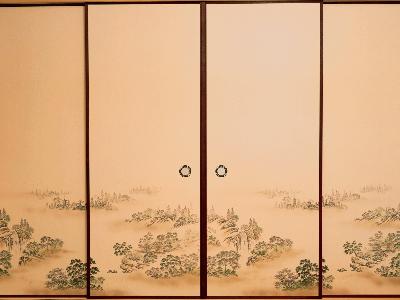ふすま Fusuma Fusuma (sliding door)
|
Fusuma developed out of the furnishings including kichou (curtained screen), tsuitate (single panel screen), byobu (folding panel screens), and akari-shoji (a translucent screen) of Shinden-zukuri (the style of aristocratic mansions) around the 8th and 9th Centuries. In the 11th Century when Yamato-e (Japanese Painting) flourished, painters began to paint their pictures on fusumas, and the noblemen favored them to decorate their houses. This way decorative function was added to fusuma, which was originally for cold protection. In the Azuchi-Momoyama period (16th Century) when Shoin-zukuri (the style of warrior residences) was established, fusuma became the media for Japanese painting. Famous painters competed to paint on fusuma in castles and temples. In the Edo period, when Sukiya-zukuri (a country house for the samurai class) style was popular, fusuma became popular among townspeople. Pictures on fusuma also changed from gorgeous ones to plain and simple ones. In the present days, a wide variety of fusuma is loved by people, from expensive fusuma that hyogu-shi (screen makers) makes to casual ones of wallpaper type.












